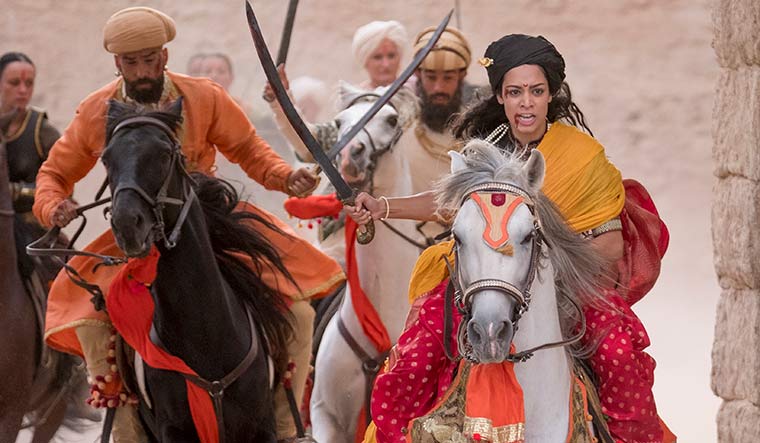When Swati Bhise was growing up in Mumbai in a family of strong Maharashtrian women, Rani Lakshmibai of Jhansi who took on the mighty British East India Company was always upheld as the epitome of valour and strength. Yet, whenever Swati was defiant or opinionated, her mother would reprimand her: “Who do you think you are, the Rani of Jhansi?”
Flash forward a few decades and Swati now has a daughter, Devika. They both live in New York. Both mother and daughter admire Lakshmibai as an iconic personality and it became a passion for them to retell the story of this freedom fighter. And thus happened the film The Warrior Queen of Jhansi.
Swati has had a distinguished career as a Bharatanatyam dancer and choreographer, and has then segued into theater and film production. She produced the Dev Patel-starred film, The Man Who Knew Infinity. Devika, who attended Johns Hopkins University and was awarded the Woodrow Wilson Fellowship, brought the Indian traditional art form of Koodiyattam to the US. She has acted in a number of theatrical and television features, and films like The Man Who Knew Infinity and The Accidental Husband.
The passion shared by the mother-daughter duo in bringing the story of Rani of Jhansi to the west was understandable, but the challenges seemed many. “We often talked about empowered women,” says Swati. “I said, ‘Why are we waiting for someone else to do this for us? I am a history major; I have done British history, Indian history; let me just jump into this and write it.”
Swati decided to direct and produce the film on her own. As a debut director, she had to figure out how to clear the hurdles of getting top-notch actors and pulling off a major film on a limited budget. The screenplay was written by Swati along with Devika and Olivia Emden. The film stars a stellar British ensemble cast headed by Rupert Everett, Nathaniel Parker, Ben Lamb, Jodhi May and Derek Jacobi. The Indian talent includes Milind Gunaji, Yatin Karyekar and Ajinkya Deo. The film had its world premiere at the Metrograph in New York. It was screened at various film festivals, too. The film will have its commercial release in India on November 29 in English and Marathi.
One major challenge faced by the Bhises was to reach out to all sorts of audience, by producing a crossover film for the current times. Devika, with her western training, brought in her own flavour to the film which stayed away from the usual Bollywood-style song and dance marathons, but kept to the true spirit of Lakshmibai’s period.
Says Devika: “I really had to commit myself to working incredibly hard on all the different parts of it—the dialects, the English accent, the action sequences, or just having the stamina to be on set every day for months, in every single scene.” She adds that she was terrified in doing the role of Lakshmibai. “I used that fear to help me become the Rani. She may also have been terrified, but she could not let anybody see it. I had to ride a horse or jump off a rampart. I could be shaking inside, but from the outside I had to be this strong leading lady. I used all of that fear to make me fearless.”
To prepare herself for the role, Devika underwent training in martial arts, horse riding and period dialect of Hindi and Marathi. She also had to work behind the cameras when Swati was hospitalised during the final days of the shoot.
Swati’s deep research and love of history paid off in the very authentic costumes and production details. She worked with designer Vidhi Singhania to bring alive the time period through the Kota and Banaras saris as well as jackets, trousers and turbans.
Perhaps, as she points out, the biggest challenge was a very tight schedule of eight weeks to finish the entire film; the crew worked six days a week, 11 hours a day. Swati’s belief in the project was the driving force; she got many forts and palace locations for free and many big names offered to help her, charmed by her passion.
Asked about the importance of the film to women across the globe, Devika says: “In America, we still have not been able to elect a woman president. India has many examples of female leaders throughout its history, and if you ask people in America, most of them do not know that. So, it was really important to me that to tell a global audience this story of an Indian woman who was a leader, a warrior in charge of men.”
Swati says that Lakshmibai is an important character not only for India but also for the international community. “She was a mother, daughter, sister, friend but above all a warrior; a warrior from within, not just a warrior out in the battlefield,” she says. “And for me, it resonates, of course, but I wanted to share the story with every woman that if all of us have even 1 per cent of the spirit of this warrior, we could fight many battles of ours and move forward without blaming anyone. We have to make the change ourselves.”
Lavina Melwani is a New York-based journalist who blogs at Lassi with Lavina



